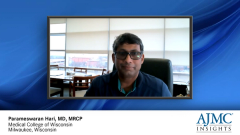
CAR T-Cell Therapy for RRMM: Measuring Outcomes
Considerations for assessing the long-term value of CAR T-cell therapies available to treat relapsed/refractory multiple myeloma.
Episodes in this series

David S. Siegel, MD, PhD: We’ve been using CAR [chimeric antigen receptor] T-cell therapy for a while now, and I think one of the remarkable things about patients who respond to CAR T cell is that, to some extent, they recover in ways that are different than with some others. One of the very pleasurable results beyond seeing the disease melt away is that the patients go back to work. They recover their functional status in a way that not a lot of other therapies do in relapsed/refractory multiple myeloma.
These patients are now eligible for other therapies when they ultimately relapse, and they’re eligible for a couple of reasons. First, is that their physical, emotional, and hematologic status allows them to tolerate these additional therapies. Secondly, the time is an important one; we’re moving very quickly now.
New therapies are coming out all the time. If you manage to control the patient’s disease and have them improve physically and mentally, 2 years from now the menu of things that we are going to have in our hands is going to be a much longer menu than the one we have today. CAR T cells are remarkable in the right patient.
Deepu Madduri, MD: We already know these patients are relapsed and refractory, the ones who have done the trials so far, and their median prior lines of therapy were 6, and they ranged anywhere from 3 to 18 for various studies. We know that these patients are already heavily pretreated. We want to make sure we offer them something that can give them deep, durable responses. Understanding that this is a one-time treatment in these patients, who will have an expected overall survival of less than 12 months, we’re seeing deep and durable remissions with CAR T. I feel like this is something that we can offer our patients and benefit them for the long term.
David S. Siegel, MD, PhD: The data about long-term value are hard to talk about beforehand. Our experiences are just starting. There are a few years, but the reality is that the number of patients is still relatively limited. I think part of the long-term value is that it is a one-off therapy. They get treated. They respond, or they don’t respond, but the rest of the time is spent monitoring until the disease comes back.
A long-term benefit from the patient’s perspective is, with the exception perhaps of stem cell transplants early on, that this is one of the very few therapies for which the patients can then go back to their life in a relatively unencumbered manner. If you’re asking from the patient’s perspective, that’s an extraordinary long-term value. If you have a patient who stays in remission for 2 years, and other than getting monitored, we’re not doing anything to them, how many opportunities do patients with multiple myeloma or cancer in general have to do that?
Overall, that’s a long-term value. In terms of the spectrum of care in myeloma, the fact that they recover and their status improves sometimes quite dramatically is of long-term value because it means that we have other options down the road to consider that we wouldn’t have had otherwise. However, regarding the true impact over time and the sequencing and things like that, we’re just too early in our experience to comment on the absolute value and the return on investment.
There are all kinds of ways to look at these things. My way of looking at it is, do I manage to make my patients feel better and live longer? That’s the long-term value for somebody like me and I assume for the patient as well.
Concerning the kind of long-term data from the ongoing CAR T-cell studies, we need to understand which kind of CAR T cells are going to be best. There are a lot of players in this space right now, and I don’t think any of us have clearly identified which ones are the best. There are allogeneic, off-the-shelf products that are being tested. There are a lot of parts, so you’re asking very complicated questions. But to me, the most critical question we need to answer is: How do we make patients with high-risk disease behave more like patients who have standard-risk disease? We’ve gotten very good at treating myeloma relative to where we were not so long ago. In our institution, for a patient who was diagnosed a decade ago, there’s a 50% probability that they’re alive today.
When I started taking care of patient with myeloma a long time ago, the median survival was measured in months. However, the one group that still we fail is the high-risk patients. I think the long-term data on treating high-risk patients relatively early during therapy are the data that I would like to see because those are the patients none of us seem to have figured out yet.
Newsletter
Stay ahead of policy, cost, and value—subscribe to AJMC for expert insights at the intersection of clinical care and health economics.



























































